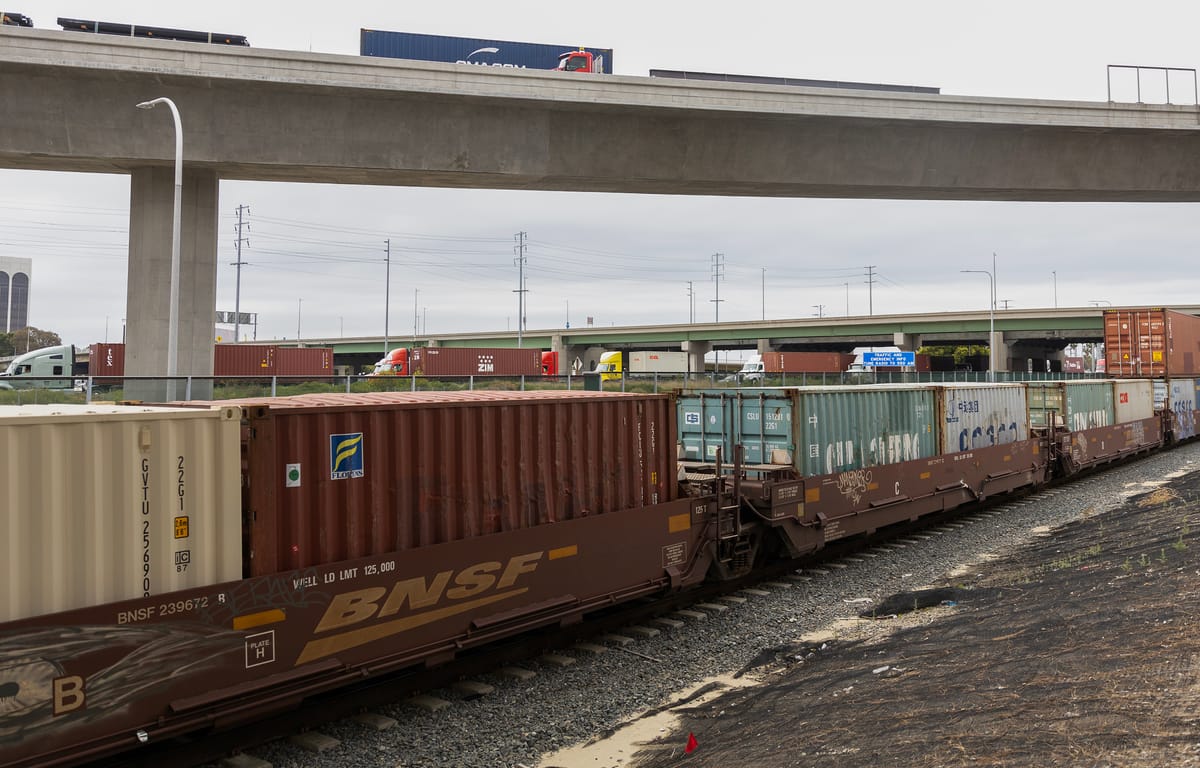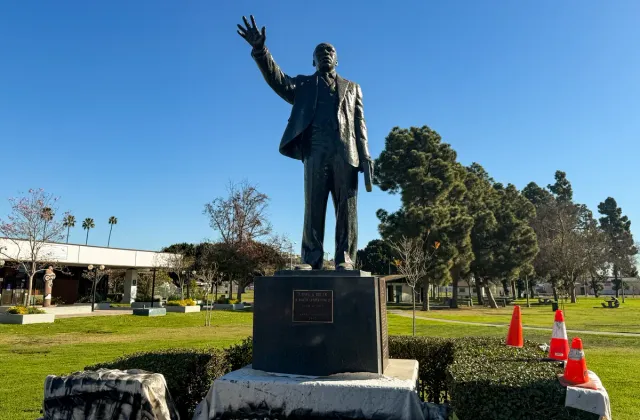A labor dispute at East, Gulf coast ports is bringing more cargo to LA, Long Beach
Dockworkers on the East and Gulf coasts could strike as early as Oct. 1 if a contract agreement isn't reached, pushing even more cargo to the West Coast, experts say.

Companies have already begun diverting cargo from ports on the East and Gulf coasts as contract negotiations between the dockworkers’ union and their employers continue.
With a contract set to expire Sept. 30 and the threat of a strike looming, West Coast ports, particularly Long Beach and Los Angeles, stand to see further cargo increases, experts say.
“Cargo owners will start diversifying their cargo way ahead of time, prospectively,” said Mike Jacob, president of the Pacific Merchant Shipping Association, adding that cargo has already been diverted to LA and Long Beach, as is evident by the record July both ports posted.
“You just don’t want to put all your eggs in one basket,” he said. “There’s just so much uncertainty out there.”
Why might there be a worker strike?
The International Longshoremen's Association represents upward of 85,000 longshoremen on the East and Gulf coasts and the Great Lakes, major U.S. rivers, Puerto Rico, Eastern Canada and the Bahamas. The United States Maritime Alliance, or USMX, meanwhile, represents container carriers, terminal operators and port associations.
Union representatives are pushing for higher pay, arguing that USMX members have recorded billion-dollar profits in recent years — profits that would not have been possible without workers moving the cargo. Other topics of negotiation, according to USMX, include employer retirement contributions and health care.
Master contract negotiations between the ILA and the USMX began in late May, but the union called off talks on June 10 citing some terminals’ use of autonomous truck processing, which doesn’t require ILA labor. Unions across the country have been pushing back on automation for years.
Since then, talks have been stagnant. In three separate press releases on June 11, July 18 and Aug. 9, USMX has stated it’s ready to return to the negotiating table. But last Thursday, USMX was informed that the ILA filed a notice with the Federal Mediation and Conciliation Service, an agency that can supply mediators to help with labor disputes.
The USMX filed a similar notice that same day in response.
Threat of an ILA strike began on June 11 when President Harold Daggett accused the USMX and its members of continuing to “drag their feet.” On July 21, Daggett wrote that the ILA has not had a strike since 1977 but that it’s time to “hit the streets.”
This month, the union announced that it would hold committee meetings in early September to make preparations for a possible strike.
On Aug. 16, International Longshore & Warehouse Union President Willie Adams pledged West Coast support for the ILA members, saying the West Coast dockworkers’ union “stands in solidarity” with its East Coast counterpart.
“From coast to coast, the ILWU and the ILA remain militant and resolute in our fight against automation,” Adams wrote in his statement. “We will not settle for a substandard deal that does not adequately address our concerns about the future of our workplace and the safety of our members.”
The ILWU declined to comment further on the potential strike or as to whether or not workers on the West Coast are prepared for an influx of cargo.
The ILWU represents around 42,000 workers at 29 ports along the West Coast, including Alaska and Hawaii.
With Democrats hoping to avoid a supply chain crisis during an election year, Jacob said it’s “likely” the government will step in to try to avert a strike. While the union has already voiced its opposition to government interference in the labor dispute, 158 state and federal trade associations co-signed a letter asking for President Joe Biden to intervene.
“One of the key priorities for the administration has been supply chain resiliency and addressing ongoing supply chain challenges,” the letter stated.
In late 2022, fearing another supply chain crisis, the federal government passed legislation to avert a rail worker strike. One of the main sticking points for the unions then was the need for guaranteed paid sick leave. While the legislation did include significant raises, the government-approved agreement omitted sick leave entirely, much to the dismay of workers and unions.
Even if Congress does not step in with a new contract, Jacob said it’s likely the administration will play at least a smaller role in mediating talks between the groups, as it did during the West Coast dock worker negotiations.
“Our nation can’t afford” a mass dockworker strike, said Tyler Reeb, interim executive director for Long Beach State’s Center for International Trade and Transportation.
Effects on the West Coast
As many learned amid the chaos of the coronavirus pandemic, the global supply chain is deeply connected. Past disruptions at Chinese ports, for example, wreaked havoc on operations at LA and Long Beach.
“Every one of these major shippers and manufacturers … have got time-sensitive inventory that needs to be on the shelf at a specific time,” Reeb said, noting they will take a less convenient route to avoid disruptions.
If the union follows through with a strike, even a one-week shutdown would cause “significant backlogs and delays” that would take four to six weeks to recover from, Maersk, the largest shipper in the world, said in a recent U.S. market update.
The subsequent supply chain crisis would drive even more cargo to the West Coast, Reeb said, adding that “the West Coast is ready.”
At the Port of Los Angeles, terminals are operating at about 85% to 90% capacity, according to spokesperson Phillip Sanfield, who agreed that workers are ready for more.
“We’ve been expecting this bump in cargo,” Sanfield said, noting that a rail worker dispute in Canada as well as the Red Sea crisis also are impacting volumes. Looming tariffs on China also have companies moving to get holiday goods imported earlier than usual.
Port of Long Beach officials declined to comment.
Regaining lost market share
The shift of cargo is a welcome change for agencies and terminal operators up and down the West Coast, which saw a notable loss in market share due to COVID-19 and recent contract negotiations.
During the pandemic backlog in 2021 and 2022 as well as during more than a year of contentious contract negotiations of their own in 2022 and 2023 that saw several unofficial labor actions, West Coast ports saw a portion of their market share leave for the other coasts. When the issues cleared up, some of that business never returned.
“This is a good opportunity for us to get a lot of that back,” Jacobs said.
Now that the tide has turned and cargo is being diverted to the West Coast, Sanfield said the port hopes some of the business will remain even after the labor negotiations get sorted.
“Perhaps some of that [business] will stick here as we move cargo efficiently for all of these companies,” Sanfield said. “That is our desire, to keep some of that long term.”

We need your support.
Subcribe to the Watchdog today.
The Long Beach Watchdog is owned by journalists, and paid for by readers like you. If independent, local reporting like the story you just read is important to you, support our work by becoming a subscriber.





